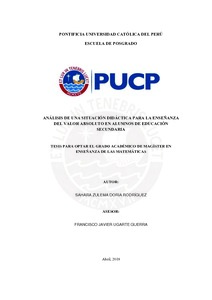| dc.contributor.advisor | Ugarte Guerra, Francisco Javier | |
| dc.contributor.author | Doria Rodríguez, Sahara Zulema | es_ES |
| dc.date.accessioned | 2018-07-23T20:05:56Z | es_ES |
| dc.date.available | 2018-07-23T20:05:56Z | es_ES |
| dc.date.created | 2018 | es_ES |
| dc.date.issued | 2018-07-23 | es_ES |
| dc.identifier.uri | http://hdl.handle.net/20.500.12404/12337 | |
| dc.description.abstract | Diversas investigaciones han reportado los errores que presentan los estudiantes cuando resuelven
ecuaciones e inecuaciones con valor absoluto, los cuales son evidencia de obstáculos epistemológicos
y didácticos. Considerar al valor absoluto de un número como el número sin signo es un obstáculo
epistemológico y la interpretación del valor absoluto de un número como un símbolo que debe ser
eliminado de manera mecánica es un obstáculo didáctico. Estos obstáculos están asociados a la
enseñanza del valor absoluto desde el contexto aritmético. En esta investigación analizamos la
propuesta curricular peruana, la cual propone enseñar el valor absoluto desde este contexto, en vista de
ello, nosotros proponemos diseñar un sistema para enseñar el valor absoluto como función, con la
finalidad de evaluar el rendimiento de los estudiantes cuando resuelven ecuaciones e inecuaciones
desde el contexto funcional. Esta investigación, toma como base teórica la teoría de situaciones
didácticas y sigue principios de la ingeniería didáctica en la metodología. Además, incorpora el
análisis cohesitivo para el diseño de la secuencia didáctica, así como para enriquecer las conclusiones.
Primero, se realizó el análisis cohesitivo de las respuestas de los estudiantes, donde se identificaron los
errores que presentan, y las implicancias que hay entre ellos, estos resultados en conjunto con los del
análisis preliminar se usaron para el diseñó la situación problema. Después, se llevó a cabo la
experimentación, la cual consistió en tres actividades aplicadas en dos sesiones con estudiantes de
tercer grado de secundaria cuyas edades oscilan entre los 13 a 14 años de edad. Finalmente, se realizó
el análisis a posteriori y el análisis cohesitivo de las respuestas de los estudiantes, concluyendo que los
estudiantes mejoraron su desempeño cuando resolvieron ecuaciones del tipo |x|=a y |x+a|=b,
recurriendo a la solución gráfica y evitando los errores de origen epistemológico y didácticos
mencionados. | es_ES |
| dc.description.abstract | Many investigations have reported the errors that the students present when they solve equations and
inequalities with absolute value, which are evidence of epistemological and didactic obstacles. To
consider the absolute value of a number as the number without sign is an epistemological obstacle and
the interpretation of the absolute value of a number as a symbol that must be eliminated mechanically
is a didactic obstacle. These obstacles are associated with the teaching of absolute value from the
arithmetic context. In this research we analyze the Peruvian curriculum proposal, which proposes to
teach the absolute value from this context, in view of it, we propose to design a system to teach the
absolute value as a function, with the purpose of evaluating the students' performance when they solve
equations and inequations from the functional context. This research, takes as a theoretical basis the
theory of didactic situations and follows principles of didactic engineering in the methodology. In
addition, it incorporates the cohesive analysis for the design of the didactic sequence, as well as to
enrich the conclusions. First, a cohesive analysis of the students' answers was made, where the errors
they presented were identified, and the implications between them. These results, together with those
of the preliminary analysis, were used to design the problem situation. Then, the experimentation was
carried out, which consisted of three activities applied in two sessions with third grade students of
secondary school whose ages range from 13 to 14. Finally, the a posteriori analysis and the cohesive
analysis of the students' answers were carried out, concluding that the students improved their
performance when they solved equations of the type | x | = a y | x + a | = b, resorting to the graphical
solution and avoiding the mentioned errors of epistemological and didactic origin. | es_ES |
| dc.language.iso | spa | es_ES |
| dc.publisher | Pontificia Universidad Católica del Perú | es_ES |
| dc.rights | info:eu-repo/semantics/openAccess | es_ES |
| dc.rights.uri | http://creativecommons.org/licenses/by-nc-nd/2.5/pe/ | * |
| dc.subject | Matemáticas--Estudio y enseñanza (Secundaria) | es_ES |
| dc.subject | Cálculo--Estudio y enseñanza | es_ES |
| dc.title | Análisis de una situación didáctica para la enseñanza del valor absoluto en alumnos de educación secundaria | es_ES |
| dc.type | info:eu-repo/semantics/masterThesis | es_ES |
| thesis.degree.name | Maestro en la enseñanza de las Matemáticas | es_ES |
| thesis.degree.level | Maestría | es_ES |
| thesis.degree.grantor | Pontificia Universidad Católica del Perú. Escuela de Posgrado | es_ES |
| thesis.degree.discipline | Enseñanza de las Matemáticas | es_ES |
| renati.discipline | 199117 | es_ES |
| renati.level | https://purl.org/pe-repo/renati/level#maestro | es_ES |
| renati.type | http://purl.org/pe-repo/renati/type#tesis | es_ES |
| dc.publisher.country | PE | es_ES |
| dc.subject.ocde | https://purl.org/pe-repo/ocde/ford#5.03.01 | es_ES |






